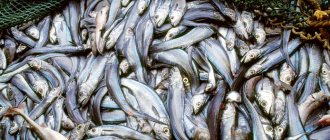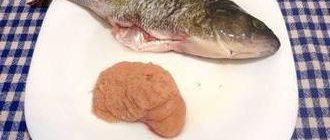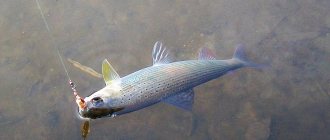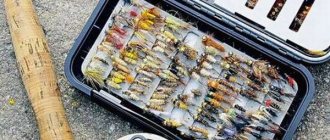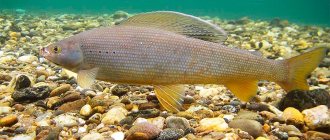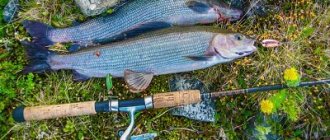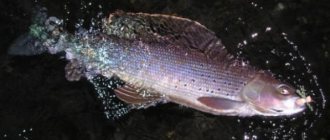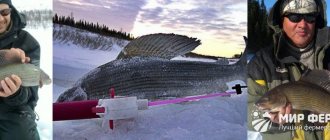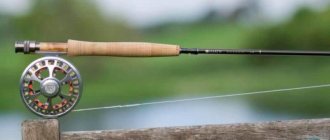Grayling
can easily be called the most beautiful fish of the salmon family. He, too, like the omul, muksun, whitefish and other honorary Siberians, belongs to the same family, albeit to a different genus. However, in appearance, grayling differs significantly from salmon and, even more so, from whitefish.
Grayling fish has always been an object of increased interest among fishermen. The thing is that it is not so easy to catch, which makes fishing full of excitement. In addition, grayling
It is distinguished by tender, fatty and very tasty meat, somewhat similar to the meat of young trout. So they catch her not just for fun. Today, amateur fishing of this fish is significantly limited; fishing is only possible under a license. However, industrial fishing is still preserved, albeit in small quantities.
Description
Grayling The slender and strong body of the grayling
is covered with fairly large, firmly held scales. The upper part and large dorsal fin are dotted with many spots. The mouth is relatively small, with a barely noticeable brush of weak teeth. The size of grayling is largely determined by its habitat conditions (food supply of the reservoir, its oxygen regime, etc.). In the rivers of Transbaikalia, for example, it reaches a kilogram weight only by the age of seven or eight years. In general, it can reach three or more kilograms.
Grayling from reservoirs in different regions of the country differ not only in size, but also in color and even body structure. Moreover, under more stable environmental conditions, the differences are less noticeable. This is understandable: over the course of centuries, natural selection took place - strong individuals survived, weak ones died, or were forced to adapt to a changing environment.
Scientists have identified several independent populations of grayling, as well as hybrid forms. In the Angara River basin, for example, the black Baikal grayling has formed a hybrid form with the “Arctic” grayling.
The range of variations in the color of grayling is quite wide. According to ichthyologists, the specific features of the pattern are formed under the influence of the degree of illumination and water temperature, the nature of the reservoir, the specific habitat and a number of other factors. The East Siberian grayling of the Lena River, for example, is noticeably different from the Amur grayling. The color of the so-called black Baikal grayling is dominated by dark tones, especially in the upper part of the body. The anal fin is orange-red. There are red-violet spots on the sides and dorsal fin. This is a slow growing form. White Baikal grayling is larger, more silvery, with a gray back.
Typically, grayling is found, the sides of which are light gray, the belly is silver, and many small black spots are scattered along the dark back. The fins are dark, sometimes with a reddish or yellowish tint. Closer to the tail there is an adipose fin, which indicates the noble origin of this fish, related to salmon.
The upper dorsal fin deserves special attention - it is fan-shaped and variegated, with small black spots. Scientists, studying grayling from a number of northern rivers, came to the conclusion that the pattern of the dorsal fin has more than forty variations. Depending on this, differences are observed between groups of fish located at a distance of 25-30 kilometers.
In general, in terms of its color, grayling is one of the most colorful and beautiful fish in our reservoirs. Various body colors play a significant role in his life. In particular, it helps to survive in extreme situations, and they constantly accompany grayling.
Grayling (Thymallus thymallus) - represented by three species - European, Siberian and Mongolian grayling and many subspecies.
European grayling can be easily recognized by their noticeably large mouth. This type of grayling lives in the basins of the Baltic and White Seas. It can also be found in the upper reaches of the Volga, Dniester, etc.
European grayling, as a rule, lives in rivers with very fast currents and a poor food supply. Perhaps this is why such grayling grows for a relatively long time.
The European grayling has dark spots on its back and sides. Brownish stripes especially emphasize the beauty of the fish. The paired fins of this fish are usually red or yellow, and the unpaired fins are purple. The European grayling has spots on its dorsal fin that have an interesting shape. During spawning, the color of grayling becomes even more attractive and bright. Siberian grayling is also called Arctic grayling. This grayling prefers only clean water enriched with oxygen. Therefore, in the south they most often live in mountain rivers and cool lakes. But in the north of Siberia, the cold climate allows graylings to live almost everywhere. These fish can feel comfortable in streams, small rivers, large rivers, and oxbow lakes. They can also live in a variety of lakes: from small tundra reservoirs to deep glacial lakes. The Mongolian species lives respectively in the reservoirs of Mongolia, in its northwestern part. This species is considered the largest of the entire grayling family.
Mongolian grayling
Mongolian grayling lives in inland waters of Northwestern Mongolia. It is very unique and has preserved primitive characteristics that clearly indicate the origin of grayling from ancestors close to salmonids. In particular, the mouth of the Mongolian grayling is very large (the end of the lower jaw extends beyond the posterior edge of the eye) and the teeth are well developed, which are reduced in other graylings. Perhaps the presence of this primitive species in the central parts of Asia indicates that it was here that the first representatives of the grayling family were formed, which then spread widely to the north, east and west.
Mongolian grayling is rather golden. The fins are dark, sometimes with a reddish or yellowish tint. Closer to the tail there is an adipose fin, which indicates the noble origin of this fish, related to salmon.
The upper dorsal fin deserves special attention - it is fan-shaped and variegated, with small black spots. Scientists, studying grayling from a number of northern rivers, came to the conclusion that the pattern of the dorsal fin has more than forty variations. Depending on this, differences are observed between groups of fish located at a distance of 25-30 kilometers.
Distribution and habitats
European grayling is widespread in the Arctic Ocean, in the White and Baltic seas, and lives in Onega, Ladoga and some other northern lakes. Found in the upper reaches of the Volga, Ural and Dniester rivers.
Siberian grayling is distributed throughout Siberia. It is most numerous in the upper tributaries of the Ob, Yenisei, Lena and Amur rivers, as well as in Lake Baikal.
Distribution and habitats of grayling
Grayling lives only in fresh water. Usually it prefers fast-moving mountain rivers with clear, cold water, choosing areas with a rocky and pebble bottom for its sites. It is most common in the reservoirs of Siberia and the Far East, and is found in the basins of the White and Baltic seas, in the Urals and in other regions of the country.
Grayling also lives in spring lakes, where it usually adheres to pebble and rocky shallows. In the rivers of the Baikal basin, he chooses bends, rifts, and shallows with fast-flowing water for parking. As a rule, it avoids deep and quiet places in the summer, and by winter it rolls into holes. In the spring, with the onset of the flood, it rises far upstream to tributaries of the second and third order, overcoming small waterfalls, rapids, rubble from trees that have fallen into the water, etc. on its way.
You have to look for grayling sites; without this, its capture can only be accidental. The larger the river, the farther from the shore the grayling tries to stay. On small rivers it usually stands below the riffles and rapids on the main stream. Reliable shelters nearby are very important for grayling. These could be sinkholes under the shore, bushes hanging over the water, or underwater vegetation. At the same time, there should be a “mirror” of open water nearby: during feeding, the grayling constantly watches the surface of the water from a shelter or from the depths - will any insect fall or swim by? For the same reason, he stands under a riffle, usually in the area where the ripples end.
In the morning and evening, grayling are less wary and can hunt close to the shore.
In relatively large rivers in summer, grayling prefers places where the flow becomes smoother and there is relative calm. Here it can be caught at a depth of 1-1.5 meters. Under the riffle, as a rule, there is a deep hole, on the slope of which the water washes out various irregularities from small pebbles and sand. There are probably graylings here.
In large lakes and reservoirs, grayling should be looked for on rocky shallows with a depth of no more than 2 meters. Near the surf shore, fishing is especially successful at the border between muddy and clear water, and near the leeward shore, in the area where the wind blows insects from coastal bushes and trees into the water.
Lifestyle and reproduction
The lifestyle of the East Siberian grayling is practically no different from the lifestyle of the Siberian grayling: it overwinters in deep sections of rivers or lakes, and in the spring, with spring high waters, it rises to small side tributaries, where it spawns.
Spawned fish first feed in the area of their spawning grounds, then gradually begin to return to their usual habitats. Grayling reaches sexual maturity at 4-5 years. Lays eggs in the amount of 1.5-11.5 thousand eggs on pebble and pebble-sand bottom. Spawning from mid to late June, following the melting of the ice.
Lifestyle
Grayling's lifestyle Grayling
is a cautious and sensitive fish. This is a predatory fish. Possessing excellent vision, smell, hearing and a well-developed lateral line, it reacts to any change in the environment. It is enough for the shadow of an angler or even the tip of a fishing rod to fall on the water, and he instantly disappears into cover, from where no tempting lures can lure him out. Therefore, the fisherman’s clothing should not contain anything bright or colorful. It is desirable that the color blends in with the surrounding vegetation or rocky shores. You must approach the proposed grayling site with extreme caution, hiding behind trees and bushes, trying not to let the shadow fall on the water.
Grayling is more or less omnivorous. It feeds on bottom organisms and insects, fry of other fish, as well as their eggs. In spring and early summer it prefers worms, caddis flies, mayflies, and dragonflies. By mid-summer, it switches to feeding on mosquitoes, horseflies, flies, grasshoppers, midges, ants, etc. Sometimes algae can be found in its stomach. According to some scientists, there are reservoirs in which grayling feed mainly on small fish. In Baikal, for example, in the autumn-winter period the diet of grayling consists mainly of yellowwing goby.
This fish spawns three times: in March, May and August. So, practically throughout the year, grayling, omul and whitefish feed on its young.
Grayling spawns in rocky shallow waters with fast currents at a water temperature of 5-10°C. Females spawn in portions (3-10 thousand eggs in total). The larvae hatch from fertilized eggs after 15-20 days. Feeding areas, where grayling spend the entire summer and part of the fall before returning to their wintering grounds (in September-October), are usually located near the spawning grounds. However, fish from some lake and river populations return to the lake after spawning to feed. Seasonal movements of herds for reproduction and development are also inherent in lake grayling, but they are naturally local in nature, since they do not extend beyond the boundaries of the lake itself.
Grayling has a stomach, so it does not feed as often as, say, roach or rudd. Having had enough in the morning, it can “melt” throughout the day, picking up only midges from the surface, but rejecting larger insects.
Grayling spawning
In early spring, even before the rivers open, to spawn, graylings leave their wintering grounds and rise up from the lower reaches of the rivers. At this time, they are often found alone, and their color becomes brighter, mainly in males, who are usually more numerous than females. Sometimes there are sterile individuals, with not bright colors and meek fins, but at the same time very fat.
Grayling spawning occurs at shallow depths and even on rifts, and this process, in general terms, is very similar to the spawning of other salmon fish, except that the time of year is different. In the southern territories, grayling spawning begins in April, in Western Europe even in March, and in the north spawning usually occurs in May and even in early June.
Spawning of grayling is long and can last almost a whole month. They probably release their eggs not at one moment, but in several stages. The largest individuals spawn first; during the spawning period they are found in pairs, a female and a male, rarely when there are more males, two or three. For her eggs, the female uses her caudal fin to dig small holes on the bottom in slow places, sweeps the eggs there, and after the eggs are fertilized by the male, the female covers the eggs with small pebbles.
Grayling eggs are not large and, as is the case with many other salmon representatives, large quantities of eggs are consumed by other river inhabitants. The eggs develop quickly, the fry have a small yolk sac, and rise to the surface of the water within a short time; after they hatch, the fry grow quickly.
Under good conditions, haruski reach a weight of 400-450 grams, or even more, after 2 years, and in the third year they reach sexual maturity. After spawning, grayling gather in small schools and eat very quickly, unlike salmon or trout.
Grayling fishing
Grayling fishing Graylings are sharp-eyed and very cautious fish.
When they see a person, they rush in different directions and, despite being sedentary, never appear in that place again. Due to such features, you need to select fishing rods of inconspicuous colors for fishing and be extremely careful yourself. The best bite occurs in the morning and evening hours; during the day it is inconsistent and rather sluggish. The exception is cloudy days, when a light wind forms small ripples on the surface of the water. On such days, grayling is less careful and takes bait floating not only on top, but also in the middle layers of the water.
In spring, bark beetles and mobile, live worms are good baits. Large graylings often stay alone, and small ones in small schools. At the beginning of summer, the best bait is shitik; in summer - all kinds of insects, preferably the caddis butterfly (shitika). In autumn, in September and November, grayling is especially bold and voracious, and is caught using a moving worm and minnow. The most sporting way of catching grayling is fly fishing, but with the advent of reel fishing, especially spinning reels, it is being replaced by wiring. Fishing in a retrieve with a long release of the float begins from the time of a fairly noticeable drop in the flood level, clarification of the water and until the appearance of aerial insects. It is more successful on bark beetles, worms and shitica. This fishing ends with the beginning of freeze-up. In autumn, the bite is best around noon and in the evening twilight. With the appearance of sludge, grayling slides downstream into the deep sections of the river.
It is possible to catch grayling from the ice in winter. It does not stop feeding in winter. But with the beginning of trout spawning, grayling does not take bait, feeding on its eggs. It can be caught from the ice using small spoons and jigs. The best spinner is narrow, up to 50 mm long, one side is silver, the other is made of red copper. The inner side must be brought to a matte shine. Fish often disappear from a single hook; it is better to hang a double hook No. 5–6 and disguise it with gray feathers, or even better, bait it with a piece of worm. The tactics for catching grayling in winter using lures are no different from catching trout; the pace of trolling is the same as for perch. After catching one, or less often two, grayling, you should not wait for bites in the same place - the fish are scared.
Just like when fishing for trout, the angler does not stay in one place for long; he constantly moves downstream, fishing every suitable place. You should not move upstream - frightened grayling, like trout, always rushes upstream and alerts others here. Caution, camouflage and keeping quiet movements when fishing for grayling are needed no less than when fishing for trout. Frequent casting alarms grayling even more than trout. You need accuracy on the first cast, on the first retrieve. As a last resort, if a hidden approach is impossible, you need to go up and lie down, hide for 5-10 minutes, and then cast the tackle. Grayling is also caught using bottom fishing (on large rivers), spinning rods and boats (on lakes).
When fishing on top, seasonal alternation of insects is used: they try to catch those that are currently flying over the reservoir. In the spring - stoneflies and caddisflies, in the summer - mayflies, botflies and butterflies, and then - grasshoppers. Fishing with artificial flies is only possible in fast currents and during ripples in the water. In calm weather and at depths, it is better to fish with natural insects. The grayling bite is lightning fast and sharp, but it can sense deception and quickly spit out the bait, so the hook should be immediate after the bite. Grayling's lips are weak; it must be fished out smoothly, using the bend of the rod. The gear is the same as for trout, but the hooks are smaller - No. 4–5. When taken out of the water, grayling quickly falls asleep and deteriorates faster than trout in hot weather. Fish caught in the summer must be immediately gutted, the gills removed and placed in a bag, covered with nettles or bird cherry. The smell of freshly caught grayling is characteristic - it smells like a young, fresh cucumber. Grayling meat has no bones. Its taste is cancelled, it is especially good in a pie.
Character and lifestyle of grayling fish
What kind of fish is grayling ? These freshwater inhabitants are distinguished by their agility, liveliness, swiftness, dexterity and strength. During the daytime, creatures prefer to hide in secluded places, at great depths, behind rocks and in algae. For wintering, fish choose deeper holes, where they hide until spring.
And already in April they go on a trip upstream of the river or along the lake, in search of small tributaries. The largest old-timers of the waters, who prefer to stay completely alone, usually swim very far in search of a favorable place for procreation.
Young and immature fish, until they grow up and mature, usually huddle in groups, spending their days in the company of their own kind. The fish meat is elastic, tasty and tender, with a pleasant smell and has a light pinkish tint, for which it is valued. Many unusual, original and delicious dishes are prepared from it; it can be boiled and fried, stewed and baked.
It is also good for pickling, and grayling soup turns out simply amazing. The meat of this fish is quick to prepare, is considered dietary and, due to its unique taste, does not require the addition of a large number of special seasonings and spices. How to catch grayling ? Fishermen prefer to fish with spoons, spinning rods and float tackle.
This activity is very exciting due to the active nature of this freshwater living creature, which is caught quite easily. For a successful catch, you should take into account the character and habits of these creatures, which most prefer to live their lives in places with fast currents, and are practically not found in grassy creeks and bays.
Grayling fishing is considered sport fishing, and only experienced fishermen can get a truly rich catch. But, unfortunately, catching this fish has recently been possible only under a license, due to a significant decrease in the number of these freshwater creatures.
A rare delicacy, grayling fish meat can be purchased in stores specializing in the sale of this type of product. Also, similar products are often offered with home delivery on various resources on the Internet. This unique product contains many vitamins, valuable fatty acids and protein, which is easily absorbed by the body. The price of grayling fish is usually about 800 rubles/kg.
Visual characteristics
The color of the black individual is predominantly dark olive, sometimes with shades of blue or large spots of red. The fins on the chest are yellow or olive in color, on the abdominal cavity - yellow shades with red stripes along the body. The fin near the anal area has a mixed shade of red and purple, there are stripes of blue with a wavy shape. The fins near the tail and fatty part are crimson in color.
The base of the belly begins a red or brick-colored stripe that extends to the end of the fin on the back. Has a longitudinal shape. There are also green, purple or red spots in the color palette. On the extreme part of the upper fin.
Baikal grayling suffer from water pollution and poaching.
The number of grayling of the white subspecies is much more modest than that of its brother. The color of the body is not so bright, dark colors predominate. The side part is painted in shades of silver or yellow, with dark spots. Back with a lot of purple. The fin is brown or gray, the dorsal part is purple with a dark tint, has 2-3 rows of transverse type, with a mixture of red and brick.
The number in catches is usually taken into account together with black Baikal grayling. In 1920-1940, the annual catch of grayling in Baikal reached 110-150 tons. Nowadays, fishing is largely uncontrolled, amateur in nature.
The fin of the black species is high, especially in the back of the fish - the fin near the dorsal and anal area is strong, the tail is short and large. The size rarely exceeds 0.6 meters, maximum weight up to 1500 grams.
To learn more:
Rotan, or firebrand fish: why is it called that?
The fish has the property of changing color during the spawning period. The body is dense, without much fat. This creates many beneficial properties and classifies fish as dietary.
Of the related forms, the closest is the Siberian species, which has fewer rays and a different size of scales. The oral cavity is smaller than that of the Baikal subspecies.
